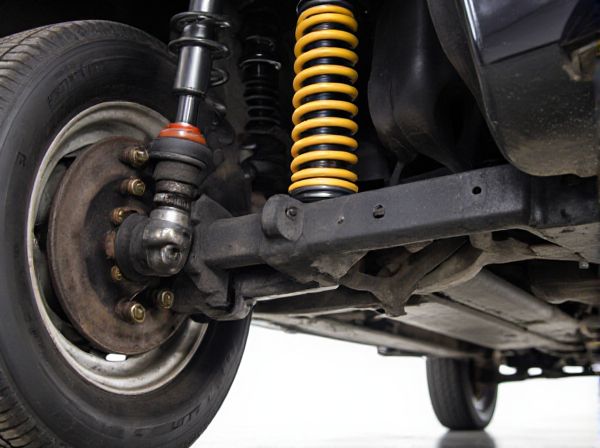
Photo illustration: Leaf Spring vs Parabolic Spring
Leaf springs consist of multiple stacked steel leaves that provide durability and are ideal for heavy loads, while parabolic springs are designed with tapered thickness to offer improved flexibility and a smoother ride. You can expect parabolic springs to reduce weight and increase comfort by minimizing friction between leaves, making them suitable for modern vehicles focusing on performance. Leaf springs are often favored in trucks and off-road vehicles due to their robustness and load-bearing capacity.
Table of Comparison
| Feature | Leaf Spring | Parabolic Spring |
|---|---|---|
| Design | Multiple stacked steel leaves | Single tapered, parabolic-shaped leaf |
| Weight | Heavier due to multiple leaves | Lighter, reduces unsprung mass |
| Ride Comfort | Stiffer, less comfortable | Smoother, better absorption of shocks |
| Load Capacity | Higher load-bearing capacity | Moderate load capacity |
| Durability | Proven, durable under heavy loads | Good durability, but less than leaf springs |
| Cost | Lower manufacturing and maintenance cost | Higher cost due to design complexity |
| Application | Heavy-duty trucks, trailers | Passenger cars, light trucks |
Introduction to Leaf Springs and Parabolic Springs
Leaf springs consist of multiple layers of flat, elongated steel strips stacked and clamped together, providing load distribution and shock absorption in vehicle suspension systems. Parabolic springs feature tapered steel leaves with varying thickness, designed to reduce stress concentration, increase flexibility, and improve ride comfort by offering progressive spring rates. Both types serve critical roles in automotive suspension, balancing strength, durability, and performance efficiency.
Historical Evolution of Suspension Systems
Leaf springs date back to ancient Roman chariots, representing some of the earliest vehicle suspension systems designed to absorb shocks using stacked metal plates. Parabolic springs emerged in the mid-20th century, innovating on traditional leaf springs by featuring tapered leaves that provided a lighter, more flexible, and efficient suspension with improved ride comfort. The transition from multi-leaf to parabolic springs marked a significant evolution in automotive suspension technology, enhancing load distribution and durability while reducing unsprung weight.
Construction and Design Differences
Leaf springs are composed of multiple layers of steel strips stacked and clamped together, creating a simple, robust design ideal for heavy-load vehicles. Parabolic springs use variable thickness steel strips tapered to a parabolic curve, reducing weight and improving flexibility by concentrating stress along the spring's length. The construction difference results in leaf springs offering durability and load capacity, while parabolic springs provide better ride comfort and reduced unsprung mass.
Material Composition and Manufacturing
Leaf springs are typically made from multiple layers of high-carbon steel, such as 65Mn or 60Si2Mn, which are stacked and clamped together to provide flexibility and load distribution. Parabolic springs use fewer leaves with varying thicknesses, often fabricated from specially treated alloy steels like 50CrV4, ensuring better stress distribution and reduced weight. Manufacturing of leaf springs involves hot or cold rolling, quenching, and tempering processes, whereas parabolic springs require precise grinding and heat treatment to achieve their tapered profile and enhanced fatigue resistance.
Performance: Ride Quality and Comfort
Parabolic springs offer superior ride quality and comfort by providing a more progressive spring rate, which reduces vibrations and absorbs shocks more efficiently than traditional leaf springs. Their tapered design allows for a lighter, more flexible structure that adapts better to uneven terrain, enhancing vehicle stability and passenger comfort. In contrast, conventional leaf springs tend to deliver a stiffer ride due to their uniform thickness, resulting in less effective impact absorption and increased road noise.
Load Bearing Capacity and Durability
Leaf springs typically offer higher load-bearing capacity due to their multi-layered design, making them suitable for heavy-duty applications such as trucks and trailers. Parabolic springs, composed of variable thickness leaves, provide enhanced durability and improved ride comfort by reducing stress concentration and weight. While leaf springs excel in handling substantial loads, parabolic springs extend lifespan and maintain performance under fluctuating stresses.
Maintenance and Longevity
Leaf springs require frequent maintenance such as regular lubrication and periodic inspection for cracks or wear, which can impact their longevity if neglected. Parabolic springs offer enhanced durability with less maintenance due to their tapered design, which distributes stress more evenly and reduces fatigue. Their improved resistance to corrosion and reduced weight contribute to longer service life compared to traditional leaf springs.
Application in Modern Vehicles
Leaf springs dominate heavy-duty trucks and commercial vehicles due to their robust load-bearing capacity and simplicity, ideal for suspension systems that require durability under heavy loads. Parabolic springs, featuring tapered thickness, are favored in modern passenger cars and light trucks for their enhanced ride comfort, reduced weight, and improved suspension flexibility. Automotive manufacturers increasingly adopt parabolic springs to optimize fuel efficiency and handling dynamics while maintaining adequate support for moderate payloads.
Cost Comparison and Value Analysis
Leaf springs offer a cost-effective suspension solution due to their simple design and widespread availability, resulting in lower manufacturing and maintenance expenses compared to parabolic springs. Parabolic springs, though more expensive initially, provide improved ride comfort and reduced weight, delivering higher value in applications where performance and fuel efficiency are priorities. Evaluating total ownership costs involves balancing the upfront savings of leaf springs against the enhanced durability and long-term benefits of parabolic springs.
Choosing the Right Spring for Your Vehicle
Choosing the right spring for your vehicle depends on factors such as load capacity, ride comfort, and vehicle application. Leaf springs offer durability and excellent load-bearing capacity, making them ideal for trucks and heavy-duty vehicles, while parabolic springs provide a smoother ride with reduced weight, suitable for passenger cars and light commercial vehicles. Understanding the differences in design and performance helps optimize suspension efficiency and vehicle handling for specific driving conditions.
 caratoz.com
caratoz.com